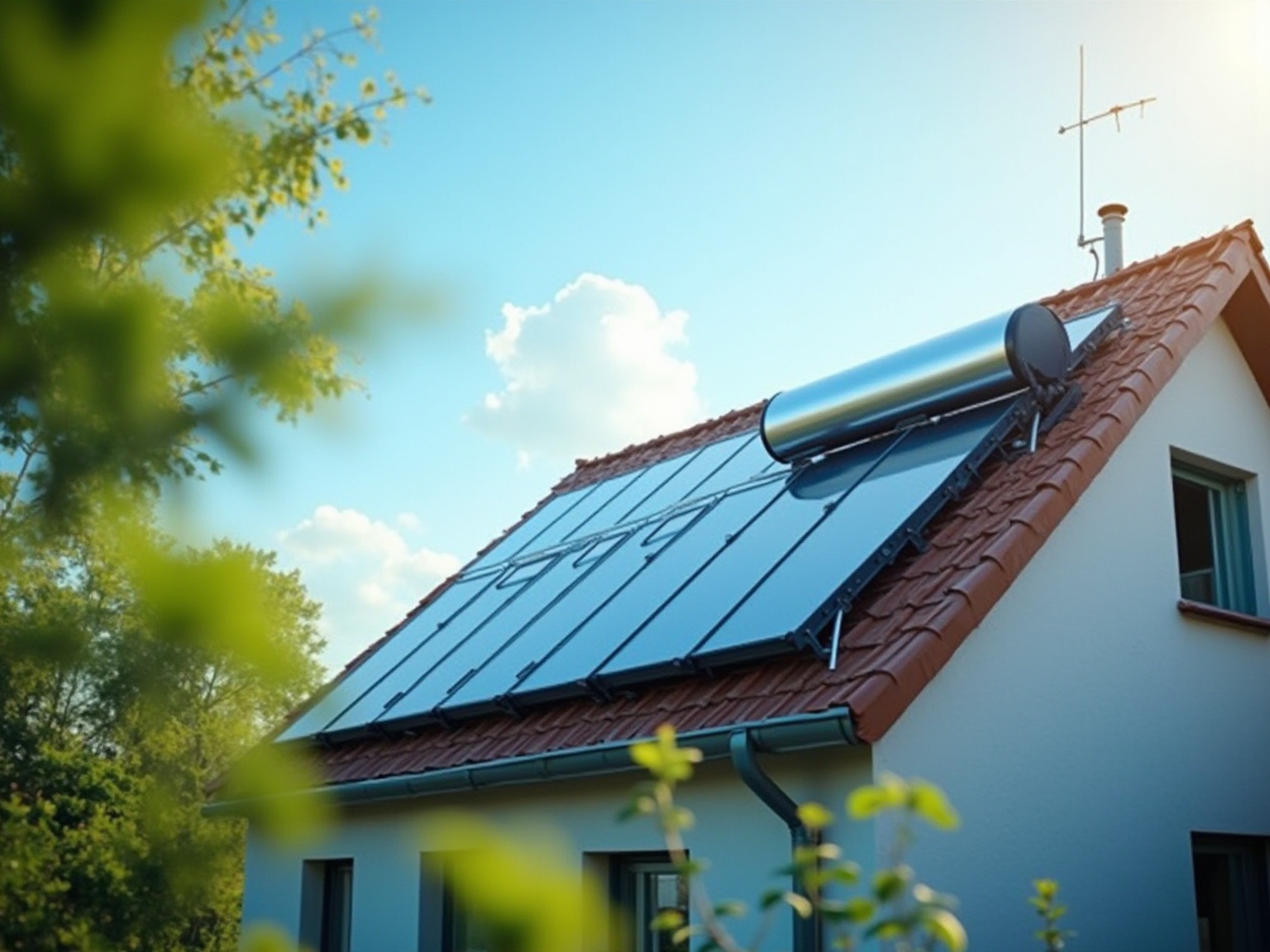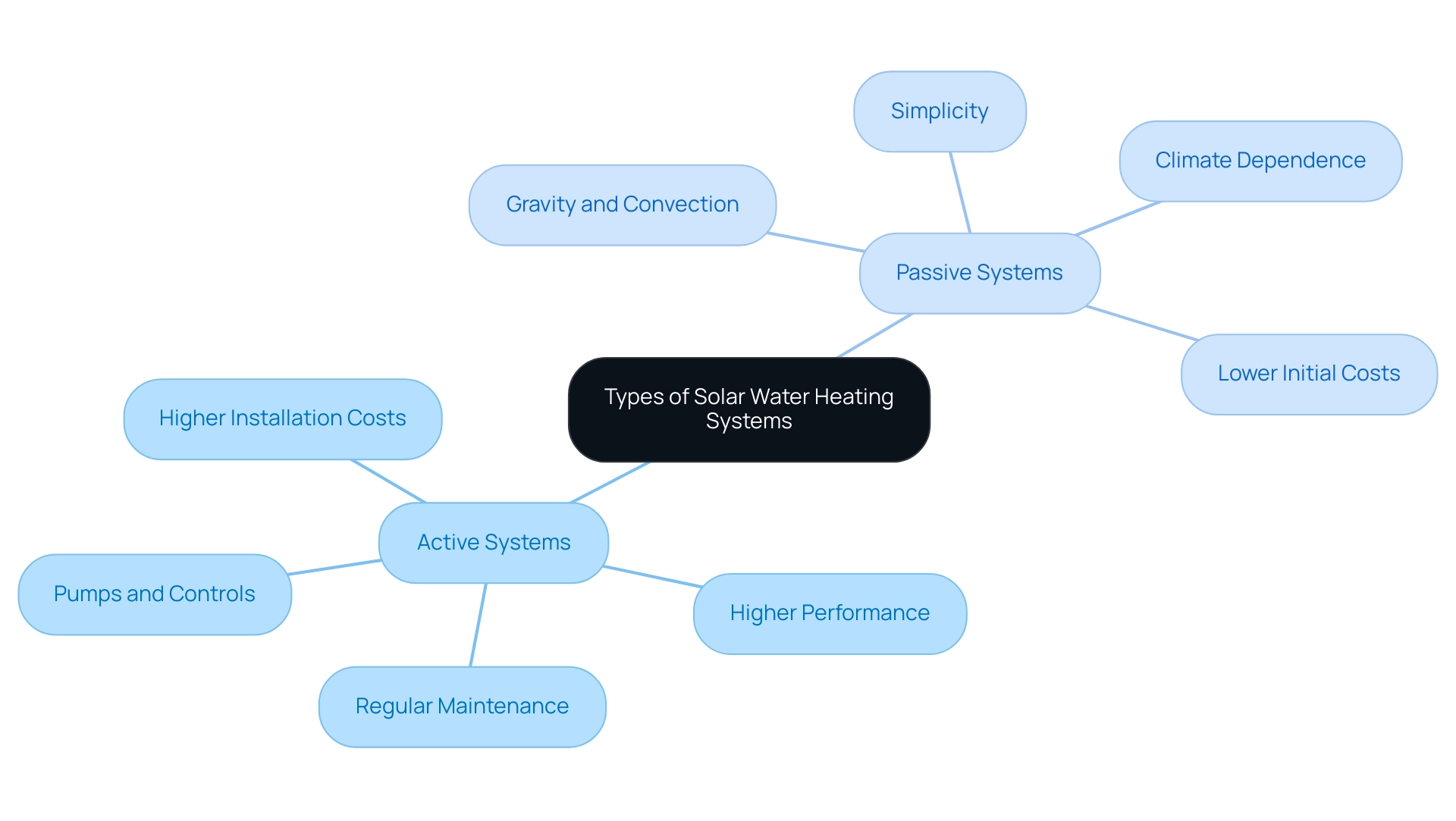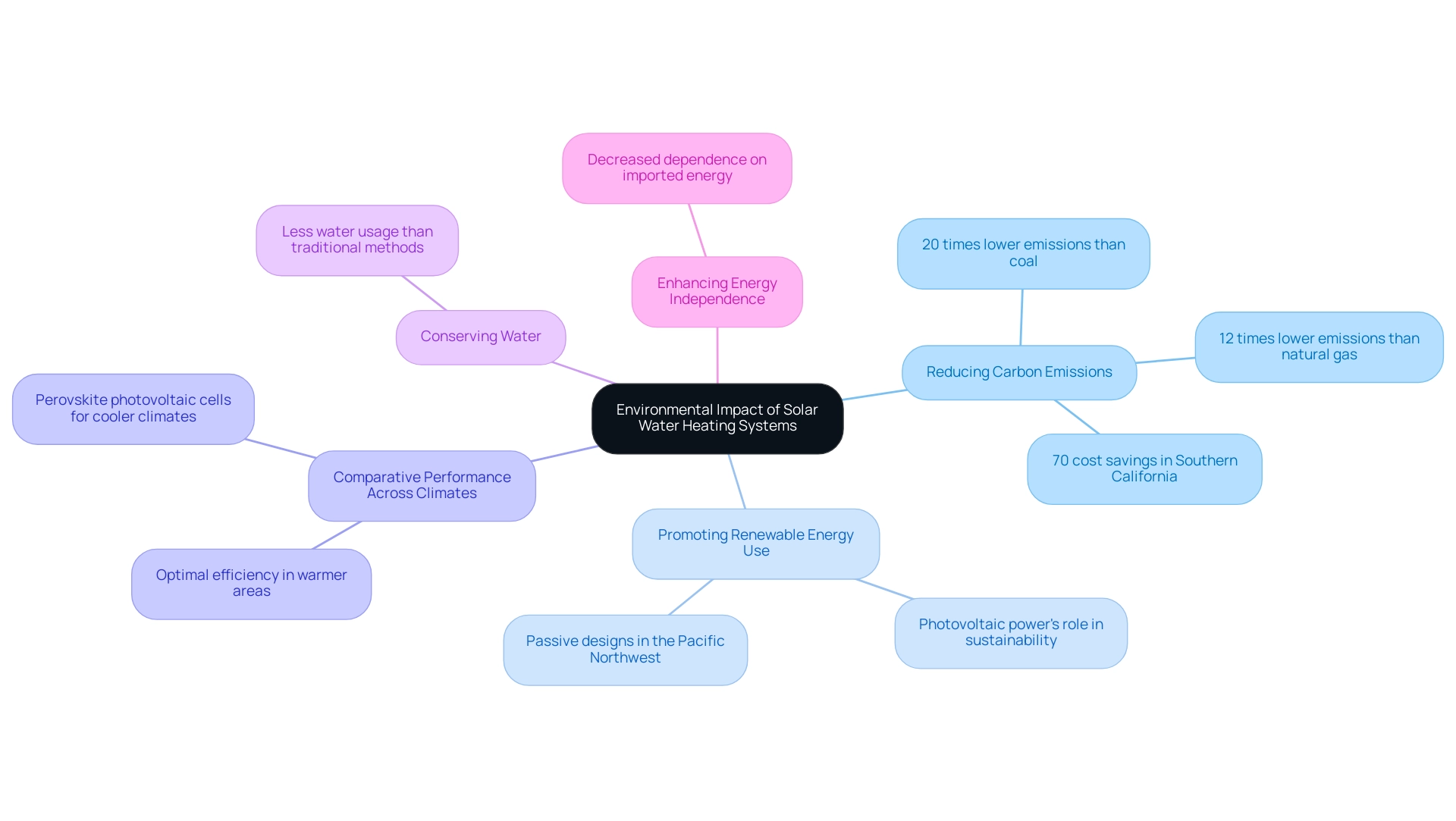Overview
Hot water solar systems work by capturing sunlight through collectors, converting it into heat that warms liquid for household uses, thereby offering significant economic and environmental benefits. The article illustrates this by detailing how these systems can drastically reduce utility bills, with some homeowners experiencing savings over 70%, while also contributing to lower carbon emissions and promoting the use of renewable energy.
Introduction
In a world increasingly focused on sustainability, solar water heating systems emerge as a beacon of innovation, harnessing the sun’s energy to provide efficient hot water solutions for homes. These systems not only promise significant reductions in energy bills but also pave the way for a greener future by minimizing carbon footprints. By utilizing advanced technologies such as solar collectors and heat exchangers, homeowners can enjoy the dual benefits of cost savings and environmental responsibility.
As the adoption of solar energy continues to rise, understanding the various types of systems, their components, and installation processes becomes essential for those looking to make an eco-conscious investment. This article delves into the intricacies of solar water heating, offering insights into its economic advantages, environmental impact, and practical guidance for installation and maintenance.
Introduction to Solar Water Heating Systems
The hot water solar system utilizes sunlight to effectively warm liquid for different household uses, such as bathing, cooking, and cleaning. These setups usually comprise collectors that capture sunlight, transforming it into heat that is transferred to liquid stored in a tank. The implementation of thermal heating technology not only utilizes renewable resources but also provides significant economic advantages.
Homeowners can experience significant reductions in utility bills, with the Southern California household seeing costs decrease over 70% after installing a solar water heating system combined with a heat exchanger. Similarly, homes in cooler areas utilizing passive power collection designs have shown remarkable efficiency, especially through the use of large south-facing windows to capture sunlight during winter, significantly lowering costs. According to Clean Energy Resource Teams, sunlight-powered air heaters can decrease carbon output by 20 to 40 percent while lowering monthly costs by 30 percent.
This increasing trend towards sustainable energy options is emphasized by the anticipated growth in in the U.S. from 2012 to 2032. As Dr. Mark Z. Jacobson, Director of the Atmosphere/Energy Program at Stanford University, states, ‘Solar PV technologies continue to improve, resulting in the continued decline in PV prices.’ This enhancement also applies to hot water solar system solutions, making them a viable choice for eco-conscious homeowners.
Furthermore, a comparative analysis of heater efficiency across various climates reveals the importance of optimal panel angles for maximum output, which enhances overall efficacy by ensuring that collectors receive the most sunlight possible. It’s important to consider installation and maintenance expenses, which can vary significantly among different types. For example, a recent case study comparing two heater models revealed that while a more efficient model (Model B) incurs an additional expense of $85, it provides estimated annual operating cost savings of $56, leading to a payback period of only 1.5 years.
Additionally, the potential of perovskite cells in energy technology offers promising advancements in efficiency and cost-effectiveness. With the growing focus on renewable energy, solar heating solutions are seen as an appealing option in 2024, showcasing progress in technology and increasing adoption rates throughout the United States.
Types of Solar Water Heating Systems: Active vs. Passive
can be classified into two main categories: active and passive. Active setups in a hot water solar system utilize pumps and advanced controls to circulate water through the collectors, enabling efficient operation across a broader range of conditions. This adaptability often results in higher performance, particularly in environments with varying temperatures, making a hot water solar system an excellent choice for homeowners who are seeking reliable energy solutions.
However, hot water solar systems require regular maintenance and typically involve higher installation costs. In contrast, the hot water solar system with passive setups relies on gravity and natural convection to warm fluids, making them simpler and generally more dependable. Although they may have reduced initial expenses, a hot water solar system might not reliably deliver adequate heated liquid in every climate, especially in regions with less sunlight.
For example, the average sunlight radiation received by the Earth is approximately 795 W/m²/hour, which can significantly affect the efficiency of passive structures. Factors such as inlet fluid temperature, ambient temperature, and insulation thickness can also impact the efficiency of collectors, which is essential for eco-conscious homeowners to take into account. According to Jennifer B., a teacher, “I would definitely recommend Study.com to my colleagues.
It’s like a teacher waved a magic wand and did the work for me. I feel like it’s a lifeline.” This viewpoint highlights the significance of trustworthy data when making choices regarding energy installations.
Homeowners should thoughtfully assess their individual situations, including local climate factors and heating requirements, to identify which hot water solar system best aligns with their eco-friendly objectives and financial plan. Moreover, when assessing various models of hot water solar systems, elements such as cost, renewable performance factor (SEF), and projected yearly operating expenses are essential. For instance, a more efficient model may have a payback period of 1.5 years, demonstrating the financial advantages of investing in higher efficiency solutions while contributing to job creation and greenhouse gas reduction.
Moreover, combining heat heaters with heat exchangers can improve overall efficiency, enabling homeowners to optimize savings and lessen dependence on conventional power sources. Real-life case studies, like those from homeowners who have effectively embraced the hot water solar system, demonstrate substantial decreases in utility expenses and reduced carbon footprints, emphasizing the financial and ecological benefits of heating innovations. By considering these factors, homeowners can make informed decisions that not only support their immediate resource needs but also align with long-term sustainability goals.
Key Components of Solar Water Heating Systems
consists of several essential elements that work together to effectively capture sunlight, offering both financial and ecological benefits to homeowners. These include:
-
Solar Collectors: Essential for capturing sunlight and converting it into usable heat, these devices are available in various designs, primarily flat-plate and evacuated tube systems.
Each design offers distinct advantages regarding efficiency and application, especially in how they integrate with panel shingles for a cohesive power solution. Recent reports indicate that the efficiency of these collectors can significantly vary, influenced by factors such as the angle of installation, local meteorological conditions, and geographical factors like the altitude of Tehran, which is 1.2 km. Additionally, the relative energy increase due to sun tracking is significantly influenced by the day of the year, emphasizing the importance of design choices in optimizing performance.
Findings from previous research by Jamil et al. also highlight that maximum power output is achieved at around 27° in India, providing a comparative perspective on solar collector efficiency and design considerations.
-
Storage Tanks: These insulated containers store the heated liquid until it’s needed, playing a vital role in maintaining temperature and ensuring a steady hot supply. For instance, homeowners can see a reduction in heating costs by utilizing these tanks effectively.
-
Pumps and Controls: Present in operational setups, these elements are accountable for moving the fluid between the collectors and the storage tank, enhancing the overall effectiveness and efficiency.
-
Heat Exchanger: This component serves to transfer heat from the solar-heated water to the potable water used in the home, ensuring that the two networks do not mix while maximizing energy efficiency.
Understanding the components of the hot water solar system is crucial for effective installation and operation, as proper integration can enhance system longevity and performance. A linear regression analysis conducted in a recent case study demonstrated that panel efficiency correlates with various meteorological parameters, including temperature and light intensity, highlighting the importance of informed design choices to maximize the benefits of this technology. As the authors of this study noted,
The authors thank their respective institutions for supporting this research and Mattu University, Ethiopia, for their extended support in this publication process.
This acknowledgment strengthens the joint efforts crucial for advancing thermal heating technology and optimizing its components, ultimately supporting long-term sustainability goals for eco-conscious homeowners. Real-life examples demonstrate that homeowners have realized up to 50% savings on their energy bills by adopting heating solutions, reinforcing the case for integrating these eco-friendly technologies into residential settings.
Installing Your Solar Water Heating System: A Step-by-Step Guide
Installing a hot water solar system requires meticulous planning and execution. Follow these steps to ensure a successful installation while maximizing both economic savings and environmental impact:
-
Assess Your Home’s Needs: Begin by evaluating your household’s hot supply requirements along with the available roof space for installation.
This initial evaluation is essential for identifying the size and type of hot water solar system that will best meet your needs, ultimately influencing your financial savings and reducing your carbon footprint.
-
Choose the Appropriate Setup: Based on your evaluation, choose between active and passive thermal heating setups. Active systems in a hot water solar system utilize pumps and controls to circulate water, while passive systems rely on natural circulation, often making them simpler and less costly to install.
-
Obtain Permits: Before proceeding, check local regulations regarding photovoltaic installations and secure any necessary permits. This step ensures compliance with building codes and local regulations, which can vary significantly by region and may also influence the incentives available to you.
-
Install Collectors: Position the collectors on your roof in a location that maximizes sunlight exposure.
Optimal placement can significantly improve the efficiency of a hot water solar system, with recent data showing that the annual average sunlight fraction can reach 71%, and even 100% during peak summer months from May to September. Regions with abundant sunlight can see a quicker return on investment, further boosting your savings.
-
Connect the Plumbing: Install the plumbing that connects to the storage tank.
Ensure to incorporate a heat exchanger if your design requires it, as this is vital for maintaining efficient heat transfer.
-
Install the Storage Tank: Choose a location for the storage tank that minimizes heat loss. The tank should be insulated and ideally placed close to the collectors to reduce heat loss through piping, thus enhancing overall efficiency.
-
Establish the Controls: For active setups, install the necessary pumps and control mechanisms to manage fluid flow and temperature settings. Proper configuration at this stage is essential for optimal performance and to maximize the economic benefits of your investment.
-
Conduct Testing: Finally, assess the entire setup to ensure that all components are functioning correctly before regular use.
This step is essential to recognize any problems that may require attention after installation.
Following these steps not only aids in a successful installation but also conforms to industry best practices, ultimately resulting in an efficient thermal heating solution. In fact, in 2013, 94% of the energy supplied by thermal heating systems was utilized for heating household hot liquid, highlighting their efficiency. Moreover, this investment in a hot water solar system can recover its cost in a reasonable period of 6–8 years, making it a financially sound choice for eco-conscious homeowners.
Homeowners can anticipate yearly savings ranging from $400 to $600, and as the worldwide market for heating continues to expand, with significant contributions expected from nations such as China, the US, and Germany—accountable for 75% of global additions in 2024—now is a perfect moment for homeowners to contemplate this eco-friendly investment. Moreover, cost estimates for household-sized thermal heaters can fluctuate considerably depending on collector type and local market conditions, with a typical average expense around $4,000. Importantly, a hot water solar system can reduce a household’s carbon footprint by preventing roughly 2 tons of carbon dioxide from entering the atmosphere annually, which is similar to not operating a vehicle for four months.
Maintenance and Repair of Solar Water Heating Systems
To ensure your hot water solar system operates efficiently and remains in good condition, follow these essential maintenance tips:
-
Regularly Check the Collectors:
Keeping the collectors clean is vital for optimal performance. Use soft bristle brushes or microfiber cloths to gently clean the surface, avoiding scratches.
A mild detergent can help remove stubborn debris, as maintaining clean surfaces is crucial for maximizing energy production and efficiency. It’s recommended to clean the collectors at least twice a year, or more frequently in dusty environments.
-
Inspect the Storage Tank:
Regularly examine the storage tank for signs of leaks or corrosion, which can lead to inefficiencies and costly repairs.
-
Monitor the Pressure:
Keep an eye on the pressure gauge, ensuring it remains within the recommended range to avoid harm to the equipment.
-
Check the Antifreeze:
For setups in colder climates, it’s crucial to check the antifreeze level to prevent freezing and potential failure.
-
Schedule Professional Inspections:
At least once a year, arrange for a professional to evaluate the setup for any potential issues. Fenice Energy, a leader in clean energy solutions, emphasizes that ‘regular maintenance not only enhances performance but also helps households save on energy costs.’ Additionally, ensure that and return pipes have a minimum slope of 0.25 inches per foot (2.1 centimeters per meter) to maintain proper flow and efficiency.
By following these guidelines, including modifying cleaning frequency based on local environmental elements, you can prevent expensive repairs and ensure your heating apparatus operates at peak efficiency, ultimately resulting in considerable long-term savings. In fact, investing in energy heaters can lead to payback periods varying from 2 to 6 years, particularly when taking into account available subsidies and tax credits. A recent case study titled ‘Cost Efficiency of Solar Water Heaters’ highlights that homeowners can achieve significant savings on utility bills, with some reporting reductions of up to 30% in their expenses, further enhancing the financial viability of these solutions while contributing to a more sustainable future.
Economic Benefits and Incentives for Solar Water Heating
Investing in a hot water solar system provides substantial financial benefits for environmentally aware homeowners. Here are some key benefits to consider:
-
Reduced Energy Bills: Homeowners can expect substantial reductions in monthly energy costs.
A well-designed hot water solar system may provide nearly all (90 percent) of your hot water in the summer and still deliver around 25 percent in winter, resulting in notable savings throughout the year. For instance, households installing heat pumps can save between $1,000 to $3,100 annually, depending on their current heating source, illustrating the potential for significant utility bill reductions compared to traditional electricity.
-
Incentives and Rebates: Numerous states and local governments provide appealing financial incentives for photovoltaic installations, including tax credits and rebates.
For instance, California homeowners can gain from programs such as the California Solar Initiative, which aids the shift to renewable energy. Additionally, until March 2028, all photovoltaic installations are eligible for zero VAT, enhancing financial appeal. Homeowners should research specific incentives available in their state, as these can vary widely and significantly impact installation costs.
Comparing these incentives across states can provide insight into the best financial options available.
-
Increased Property Value: Properties equipped with photovoltaic technology typically experience an increase in market value, making them more attractive to potential buyers. Additionally, thermosyphon units, with a majority capacity of 40 gallons, are popular among homeowners looking to maximize efficiency and property value.
Long-Term Savings: While the upfront expenditure in heating systems can be significant, the long-term savings on utility costs can effectively balance out these expenses. Research suggests that households installing heat pumps can save between $1,000 to $3,100 each year, reinforcing the economic feasibility of renewable energy options over conventional heating methods. Moreover, when assessing heating solutions like a hot water solar system compared to conventional electric heaters, the savings can be even more evident, particularly in regions with .
Comprehending these financial factors is essential for homeowners considering renewable options. By weighing the initial costs against long-term benefits and available incentives, homeowners can make informed decisions that align with their financial goals and eco-conscious values. Furthermore, investigating various solar service providers can assist homeowners in discovering the best value in solar solutions.
Environmental Impact of Solar Water Heating Systems
Solar water heating solutions provide that correspond with sustainable living practices:
- Reducing Carbon Emissions: By utilizing renewable sources, these systems drastically cut reliance on fossil fuels, resulting in greenhouse gas emissions that are approximately 12 times lower than those from natural gas and 20 times lower than coal. Case studies have shown that households in regions like Southern California have achieved over 70% savings in costs by adopting these technologies, significantly lowering their carbon footprint.
- Promoting Renewable Energy Use: The implementation of photovoltaic power plays a crucial role in guiding the power market towards sustainability, encouraging broader acceptance of renewable technologies. For example, a residence employing passive power designs in the Pacific Northwest successfully harnessed sunlight through large south-facing windows, showcasing the adaptability of thermal heating across various climates.
- Comparative Performance Across Climates: Solar heating units demonstrate differing efficiencies depending on local climates. In warmer areas, setups can function at optimal efficiency throughout the year, whereas in cooler environments, creative designs like perovskite photovoltaic cells can improve performance by maximizing power capture even in less advantageous conditions.
- Conserving Water: Unlike traditional heating methods, a hot water solar system requires significantly less water, making it especially beneficial in areas facing water scarcity.
- Enhancing Energy Independence: By utilizing local sunlight resources, homeowners can decrease their dependence on imported energy sources.
Comprehending these environmental advantages can motivate homeowners to adopt renewable energy options, contributing to a healthier planet. Furthermore, initiatives like the Climate, Conservation, Community Initiative are working to develop flexible land use solutions for renewable energy, which are expected to deliver economic, social, and ecological advantages to communities. This initiative reinforces the value of adopting hot water solar systems by demonstrating how such solutions can lead to tangible benefits for both the environment and local economies.
Conclusion
Solar water heating systems stand at the forefront of sustainable energy solutions, offering homeowners a pathway to significant financial savings and a reduced carbon footprint. By harnessing the sun’s energy, these systems not only provide efficient hot water for everyday needs but also contribute to a greener future. The advantages of implementing solar water heating technology are numerous, ranging from substantial reductions in energy bills to various state and local incentives that make the initial investment more manageable.
Understanding the differences between active and passive systems is crucial for homeowners looking to make informed decisions. Each type offers distinct benefits, and careful consideration of local climate conditions and hot water requirements can lead to optimal system performance and efficiency. Furthermore, the key components of these systems—such as solar collectors, storage tanks, and heat exchangers—play an essential role in maximizing energy capture and ensuring long-term functionality.
Installation and maintenance are equally important aspects that can influence the overall effectiveness of solar water heating systems. By following a structured installation process and adhering to regular maintenance schedules, homeowners can ensure their systems operate at peak efficiency, resulting in continued savings and environmental benefits over time.
Ultimately, the transition to solar water heating is not just an investment in energy savings; it is a commitment to sustainability and environmental stewardship. As technology continues to advance and adoption rates increase, embracing solar solutions will play a vital role in shaping a more sustainable future for generations to come. Now is the time for homeowners to consider this eco-friendly investment, aligning their energy choices with both economic benefits and a commitment to protecting the planet.





